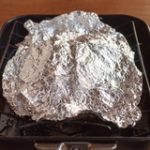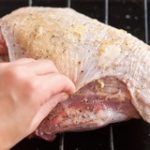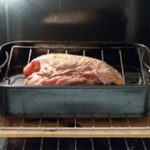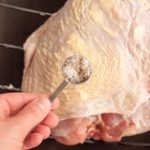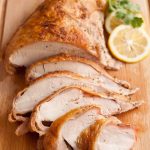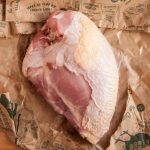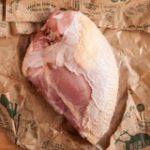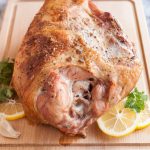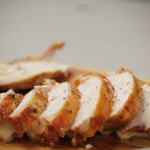Recipe of the week
By Emma Christensen From The Kitchn
Are you hosting a smaller Thanksgiving this year? Don’t bother with a whole turkey — just roast a turkey breast! One half-breast or even a whole turkey breast makes more than enough for a small party of four to six. (And yes, you’ll still have plenty of pan drippings to make gravy.)
Turkey breasts are also a cinch to roast. No flipping, no basting, no fuss. Here’s a recipe to show you how to do it, step by step.
How To Cook Turkey Breast: Watch the Video
Other Reasons Why You Might Roast a Turkey Breast
A small-scale Thanksgiving isn’t the only reason why you might think about roasting a turkey breast on its own. Here are a few more times when turkey breast is a good idea.
Extra white meat: Does your family prefer white meat over dark meat? Then roasting an extra turkey breast makes sense.
A few extra guests: If you have a few too many guests for your turkey, but not quite enough to justify a whole second bird, then it’s turkey breast to the rescue.
Trial run: If you’re thinking of trying a new spice rub or roasting method for Thanksgiving, but are nervous about how it might work, do a trial run with turkey breasts.
Year-round turkey: A turkey breast is the perfect size for a week’s worth of sandwiches.
What Turkey Breast to Buy
Most grocery stores sell turkey breasts year-round. You’ll either find them in the chest coolers or in the butcher’s display case. For this method, buy bone-in and skin-on breasts.
One (three-pound) half-breast will feed two to four people. A whole (six- to seven-pound) turkey breast (two breasts, still joined at the breast bone) will feed six to eight people. This method here will work for either amount of meat.
Prepping the Turkey Breast for Cooking
Make sure your turkey breast is thawed before roasting. Generally, a totally frozen turkey breast will thaw in about 24 hours in the fridge. Once thawed, the turkey can be kept refrigerated for several days before roasting.
Turkey breasts can also be dry-brined or wet-brined, just like turkey. Be sure to start either of these methods the day before you plan to cook.
(Image credit: Emma Christensen)
The Cooking Method
I cook turkey breasts almost exactly the same way that I cook a whole turkey: I start it in a hot 450°F oven to start the browning and then turn down the heat to 350°F so that the breast meat cooks through slowly. The turkey breast on its own will usually cook more quickly than the whole turkey, so start checking it after an hour and continue roasting until it registers 165°F in the thickest part of the meat. Because it’s quicker to cook, I also don’t bother with basting.
I also roast a turkey breast on a roasting rack in a roasting pan to elevate it off the bottom of the pan. But because a turkey breast is smaller, you don’t necessarily have to use a roasting pan. You can also use an oven-safe skillet or any baking dish that will hold the breasts. Instead of a roasting rack, you can roast the turkey breast over thick-cut onions and potatoes (instant side dish!).
Let the turkey breast warm and preheat the oven to 450°F: Transfer the turkey breast to the rack inside a roasting pan, or place on top of vegetables in a skillet or other baking dish. Let the breast warm on the counter while the oven heats. Preheat the oven to 450°F. Place an oven rack in the bottom third of the oven.
Let the turkey breast warm and preheat the oven to 450°F: Transfer the turkey breast to the rack inside a roasting pan, or place on top of vegetables in a skillet or other baking dish. Let the breast warm on the counter while the oven heats. Preheat the oven to 450°F. Place an oven rack in the bottom third of the oven.
Pat the skin of the turkey breast dry with a paper towel.
Rub the turkey breast with butter and seasonings: Rub the turkey breast all over with butter.
If desired, loosen the skin and rub some butter into the meat under the skin as well.
Sprinkle the breast all over with salt and pepper (with some under the skin, if desired).
Rub the seasonings into the skin.
If you’re cooking a half-breast, pull the skin to cover the meat as much as possible.
Lower the oven to 350°F and roast the turkey for 1 hour: Place the turkey in the oven and immediately lower the heat to 350°F. Roast for 1 hour, then begin checking the temperature.
Cover the turkey to prevent over-browning: If the skin over the breast meat begins to brown too darkly toward the end of cooking, cover it with aluminum foil to prevent scorching.
Check the turkey’s temperature: The turkey is done when it reaches 165°F in the thickest part of the breast meat. Start checking after 1 hour of roasting and continue checking every 10 to 15 minutes until the breast is cooked through.
Rest the turkey: When cooked, remove the turkey from the oven and cover it loosely with foil. Rest the turkey for 15 to 20 minutes; this gives the juices time to redistribute and the turkey time to firm up. (Pour the drippings and juices from the pan into a measuring cup for making gravy!)
Carve the turkey: Carve the turkey beginning at the breast bone. Continue carving, keeping your knife as close to the ribs as possible, until the whole breast is carved from the bone.
Once no longer attached to the bone, slice the breast crosswise into slices.
How To Cook Turkey Breast
Serves 4 or more
What You Need
Ingredients
3 to 7 pounds thawed, bone-in, skin-on turkey breast (1 half-breast or 1 whole turkey breast joined at the breast bone)
1 tablespoon butter or extra-virgin olive oil
1 tablespoon kosher salt
1/2 teaspoon black pepper
Equipment
Roasting pan, oven-proof skillet, or other baking dish large enough to hold the whole breast
Roasting rack, or thick-cut vegetables to lift the breast off the pan
Measuring spoons
Aluminum foil
Instructions
Let the turkey breast warm: Transfer the turkey breast to the rack inside a roasting pan, or place on top of vegetables in a skillet or other baking dish. Let the breast warm on the counter while the oven heats.
Preheat the oven to 450°F: Place an oven rack in the bottom third of the oven.
Rub the turkey breast with butter and seasonings: Pat the skin of the turkey breast dry with a paper towel. Rub the turkey breast all over with butter. If desired, loosen the skin and rub some butter into the meat under the skin as well. Sprinkle the breast all over with salt and pepper (with some under the skin, if desired). Rub the seasonings into the skin. If you’re cooking a half-breast, pull the skin to cover the meat as much as possible.
Lower the oven to 350°F and roast the turkey for 1 hour: Place the turkey in the oven and immediately lower the heat to 350°F. Roast for 1 hour, then begin checking the temperature.
Check the turkey’s temperature: The turkey is done when it reaches 165°F in the thickest part of the breast meat. Start checking after 1 hour of roasting and continue checking every 10 to 15 minutes until the breast is cooked through.
Cover the turkey to prevent over-browning: If the skin over the breast meat begins to brown too darkly toward the end of cooking, cover it with aluminum foil to prevent scorching.
Rest the turkey: When cooked, remove the turkey from the oven and cover it loosely with foil. Rest the turkey for 15 to 20 minutes; this gives the juices time to redistribute and the turkey time to firm up. (Pour the drippings and juices from the pan into a measuring cup for making gravy!)
Carve the turkey: Carve the turkey beginning at the breast bone. Continue carving, keeping your knife as close to the ribs as possible, until the whole breast is carved from the bone; some meat will still be left on the bone. Once no longer attached to the bone, slice the breast crosswise into slices.
Recipe Notes
Turkey breasts can also be dry-brined, wet-brined, or seasoned with any mix of herbs or spices desired.
ALL IMAGE CREDITS: Emma Christensen
For more on this story and video go to: http://www.thekitchn.com/how-to-cook-turkey-breast-the-simplest-easiest-method-cooking-lessons-from-the-kitchn-213324?utm_source=RSS&utm_medium=feed&utm_campaign=Feed%3A+apartmenttherapy%2Fthekitchn+%28TK+Channel%3A+Main%29


